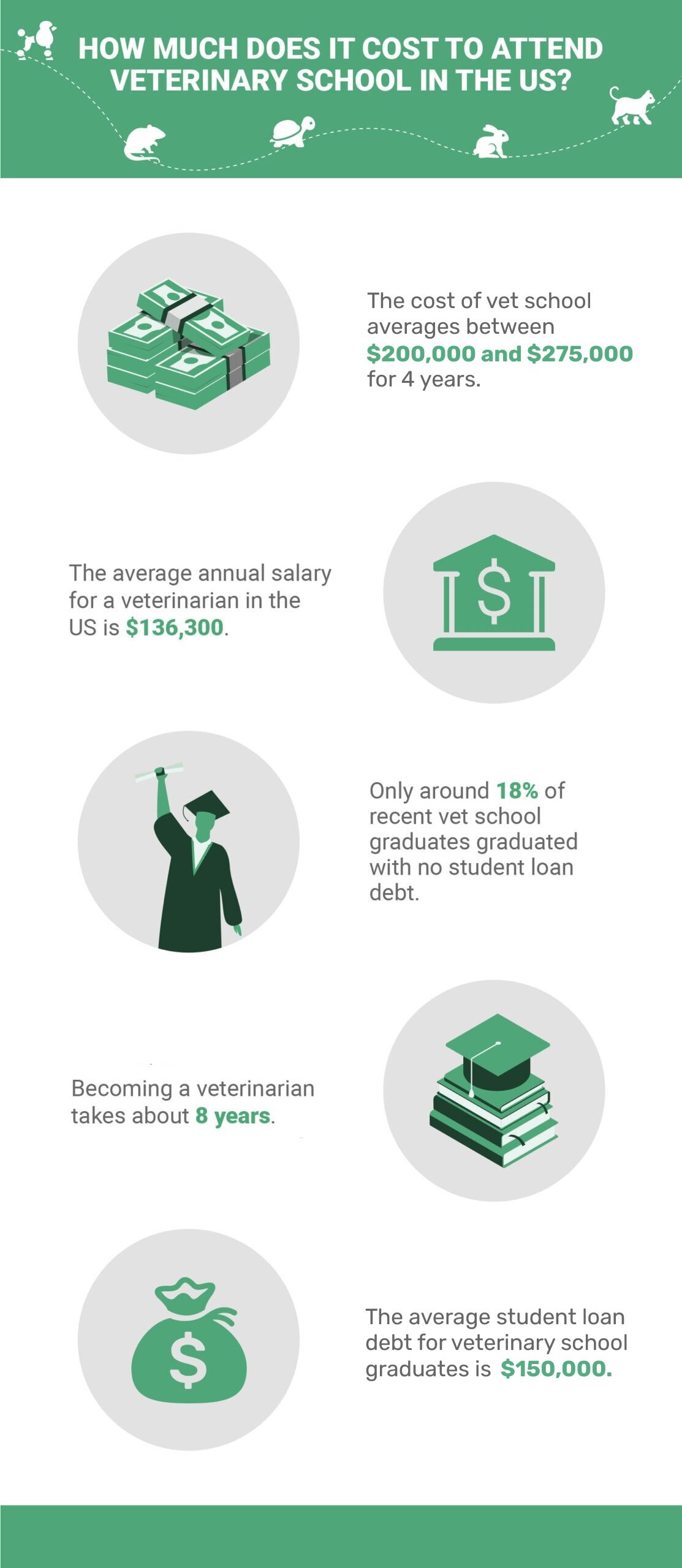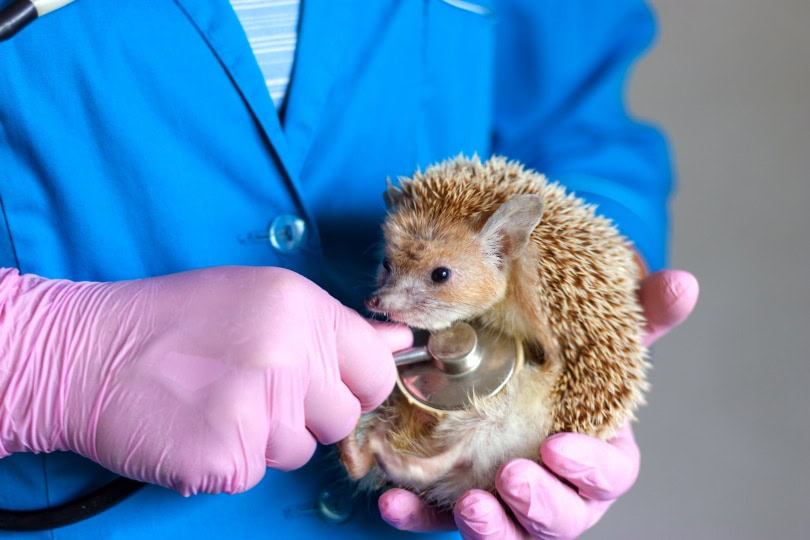Click to Skip Ahead
Note: This article’s statistics come from third-party sources and do not represent the opinions of this website.
Animal lovers often spend their entire childhood dreaming of becoming veterinarians. Vets are integral to helping people maintain the health and wellness of pets, livestock, wildlife, and zoo animals. They can serve in various roles, which may include working in private practice, for the government, as a professor, and even in a laboratory!
Veterinarians often have knowledge of a wide variety of medical conditions, surgeries, and care for many types of animals. Vet school can be challenging and expensive, though, so it isn’t the best option for everyone.
The cost of vet school is roughly between $200,000 and $275,000 for 4 years. If you’re interested in attending vet school or are just curious about what it takes to attend one, keep reading!

Top 10 Cost of Veterinary School Statistics
- The cost of vet school averages between $200,000 and $275,000 for 4 years.
- As of 2022, the least expensive vet school in the US is Purdue University, costing as little as $81,000 for 4 years.
- The most expensive vet school in the US as of 2022 is the University of California-Davis, coming in at $132,100 for in-state students and $289,597 for out-of-state students.
- Contrary to popular belief, vets do not make nearly as much money as human physicians, with an average salary of $136,300.
- The average student loan debt for veterinary school graduates is $150,000.
- Around 18% of the 2022 vet school graduates graduated with no student loan debt.
- Although the number of graduates with no student loan debt is increasing, so is the number of students reporting debts greater than $300,000, which hit 10.7% in 2019.
- Becoming a veterinarian takes about 8 years.
- The time involved to achieve a veterinary specialty can add 3–4 years to the time it takes to become a vet and begin working in the field.
- The time commitment doesn’t end after school, with around 33% of vets working 50 or more hours per week.


In-State vs Out of State Expenses
1. The cost of vet school averages between $200,000 and $275,000 for 4 years.
(Yahoo)
The average cost of vet school can be around $200,000 for in-state students. For out-of-state students, the cost rises to an average of $275,000. This cost doesn’t include undergraduate expenses and is unlikely to include things like books, room, and board.
2. As of 2022, the least expensive vet school in the US is Purdue University, costing as little as $81,234 for 4 years.
(Credible)
Purdue University is in Indiana. For in-state students, Purdue’s veterinary program costs approximately $80,734 for all 4 years. For out-of-state students, the program runs approximately $170,742.

3. The most expensive vet school in the US as of 2022 is the University of California-Davis, coming in at $132,100 for in-state students and $289,597 for out-of-state students.
(Credible)
To attend the University of California-Davis, students should expect to spend a minimum of $132,100 for in-state tuition fees. For out-of-state students, that expense increases to $289,597.

Vet School Debt
4. Contrary to popular belief, vets do not make nearly as much money as human physicians, with an average salary of $136,300.
(BLS)
The average annual salary for a veterinarian is $136,300. Meanwhile, the average pay for physicians in the US is $248,640.
5. The average student loan debt for veterinary school graduates is $150,000.
(AVMA)
For students graduating from vet school, around 11% of them are looking at student loan debt between $150,000 and $174,999. Around 10% of these graduates owe between $175,000 and $199,999. Around 1% of vet school graduates owe $400,000 or more in student loan debt.

6. Around 18% of the 2022 vet school graduates graduated with no student loan debt.
(AVMA)
Although difficult to achieve, it is possible to make it through vet school with no debt. Just ask the 18% of the graduating class of 2022 who graduated with no student loan debt! Thanks to grants, scholarships, and work opportunities through some schools, there are ways to eliminate or decrease the student loan debts that come out of vet school. In fact, the number of graduates reporting no student loan debt has been trending upward for almost 10 years.
7. Although the number of graduates with no student loan debt is increasing, so is the number of students reporting debts greater than $300,000, which hit 10.7% in 2019.
(AVMA)
As of 2019, 10.7% of vet school graduates reported having student loan debts totaling greater than $300,000. Although the number of graduates with no debt has been trending upward, so has the number of graduates with large amounts of student loan debt. In 2013, fewer than 1% of vet school graduates reported having student loan debt exceeding $300,000.

The Time Investment
8. Becoming a veterinarian takes about 8 years.
(US News)
It takes about 8 years to become a veterinarian between undergraduate and advanced courses. On top of a 4-year degree, most vet schools require 3 years of classroom and lab work and a year of clinical work in a vet clinic or hospital. Many graduates pursue a 1-year internship after graduating to garner more experience.
9. The time involved to achieve a veterinary specialty can add 3–4 years to the time it takes to become a vet and begin working in the field.
(Doctorly)
The American Veterinary Medical Association recognizes 46 veterinary specialties. After graduating, a vet must commit to an additional 3–4 years of training to achieve board certification in one of these specialties.

10. The time commitment doesn’t end after school, with around 33% of vets working 50 or more hours per week.
(Doctorly)
According to a Bureau of Labor Statistics report, one in three veterinarians reports working at least 50 hours per week. This is often due to the pressure to meet job performance metrics, help more animals, catch up on documentation after hours, or cover needs for nights, weekends, and holidays.

Frequently Asked Questions About Vet Schools
Is it easy to get into vet school?
No, it can actually be quite difficult to get into vet school. There are only 32 accredited vet schools in the United States, which means that programs can be competitive and have the option to pick from the best of the best students. (AVMA)
Is a bachelor’s degree required for vet school?
Having a bachelor’s degree is not required for some vet schools, though it does give you a competitive edge when looking for program acceptance. All vet schools require students to have completed a certain number of semester hours for acceptance, though. Most schools require somewhere between 45 and 90 semester hours to be considered for acceptance. (Doctorly)
What do other vet school expenses cost?
The cost of things like books, room, and board will vary between schools and can even vary depending on whether you are an in-state or out-of-state student. However, vet school books can easily exceed $1,000 per semester, while room and board can exceed $10,000 per semester, and lab fees can exceed $100 per class that requires lab hours.
Is it easy to get a job as a vet after graduation?
How difficult it is to get a job as a vet can vary based on the area you live in. However, veterinary medicine is a growing job market. The job outlook for veterinarians shows a 17% increase between 2020 and 2030, with an additional 14,500 jobs for veterinarians anticipated to be created. (Bureau of Labor Statistics)
- Related Read: What Is the Cost of Veterinary School in Canada?

Conclusion
Vet school is a time-consuming undertaking that can cost hundreds of thousands of dollars. Competition for acceptance into a program is high, and school can be stressful and difficult, as can being a veterinarian. When it comes to the monetary aspect of things, there are options like student loans, grants, and scholarships, all of which can help make vet school a real option for many people who would otherwise not have the means.
See Also:
Featured Image Credit: Elnur, Shutterstock










